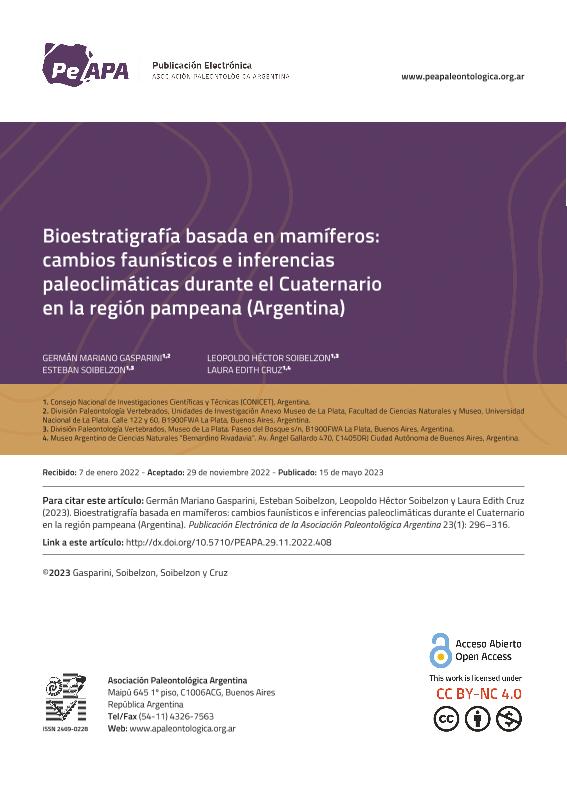Artículo
A partir de la última década del siglo XX, siguiendo la tendencia mundial al desarrollo de esquemas cronológicos con base bioestratigráfica, comenzaron las contribuciones de Eduardo Pedro Tonni, Alberto Luis Cione y colaboradores sobre esta temática en Argentina. Ellos propusieron para el sector oriental de la región pampeana de Argentina, una secuencia bioestratigráfica casi continua desde el Mioceno Tardío hasta el Holoceno. La misma conforma actualmente la base de la escala cronológica para el Cenozoico tardío continental de América del Sur. El refinamiento de la secuencia bioestratigráfica pampeana permitió: 1-establecer la cronología para el arribo de los mamíferos de origen holártico al extremo más austral de América del Sur durante el Gran Intercambio Biótico Americano; 2-precisar la dinámica faunística e interpretar los cambios paleobiogeográficos vinculados a las fluctuaciones climáticas del Cenozoico tardío; y 3-establecer correlaciones entre las secciones tipo de la región pampeana con áreas extra-pampeanas, incluso de otros países del continente. Resulta indiscutible la labor desarrollada durante más de 30 años de trabajo liderado por Tonni y Cione en colaboración con otros especialistas, para rever el concepto de “Edades Mamífero” y retornar a la clasificación cronoestratigráfica-geocronológica con base bioestratigráfica. En este contexto, aquí realizamos una actualización y síntesis del esquema bioestratigráfico, de su composición mastofaunística y de los principales cambios climáticos ocurridos durante el Cuaternario en la región pampeana, junto a una breve sinopsis de la carrera de E. P. Tonni y su aporte a la paleontología de vertebrados. Since the last decade of the 20th century, following the worldwide trend towards the development of chronological schemes with a biostratigraphic basis, contributions by Eduardo Pedro Tonni, Alberto Luis Cione, and collaborators began on this subject in Argentina. They proposed a almost continuous biostratigraphic sequence since the Late Miocene to the Holocene in the eastern pampean region of Argentina. Nowadays, it constitutes the chronological scale of the continental late Cenozoic of South America. The refinement of the Pampean biostratigraphic sequence made possible 1-to establish the chronology of the arrival of North American mammals immigrants to the southernmost South America during the Great American Biotic Exchange; 2-to improve the understanding of the faunal dynamics and the interpretation of the paleobiogeographic changes linked to the climatic fluctuations of the late Cenozoic; and 3-allowed establishing correlations between the type sections of the pampean region with other regions of the continent. The 30 years of scientific research by Tonni and Cione are unquestionable, in collaboration with other specialists, in reviewing the concept of “South American Land Mammal Ages” and to return to the chronostratigraphic-geochronological classification with a biostratigraphic basis. In this context, we updated and synthetized the biostratigraphic scheme, its mastofaunal composition, and the main climatic changes that occurred during the Quaternary in the pampean region, along with a brief synopsis of the career of E. P. Tonni and his contribution to paleontology of vertebrate.
Bioestratigrafía basada en mamíferos: cambios faunísticos e inferencias paleoclimáticas durante el Cuaternario en la región pampeana (Argentina)
Título:
Biostratigraphy based on mammals: faunal changes and paleoclimatic influences during the quaternary in the pampean region (Argentina)
Fecha de publicación:
05/2023
Editorial:
Asociación Paleontológica Argentina
Revista:
Publicación Electrónica de la Asociación Paleontológica Argentina
e-ISSN:
2469-0228
Idioma:
Español
Tipo de recurso:
Artículo publicado
Clasificación temática:
Resumen
Palabras clave:
South America
,
Biotic Interchange
,
Megafauna
,
Paleoclimates
Archivos asociados
Licencia
Identificadores
Colecciones
Articulos(CCT - LA PLATA)
Articulos de CTRO.CIENTIFICO TECNOL.CONICET - LA PLATA
Articulos de CTRO.CIENTIFICO TECNOL.CONICET - LA PLATA
Citación
Gasparini, Germán Mariano; Soibelzon, Esteban; Soibelzon, Leopoldo Héctor; Cruz, Laura Edith; Bioestratigrafía basada en mamíferos: cambios faunísticos e inferencias paleoclimáticas durante el Cuaternario en la región pampeana (Argentina); Asociación Paleontológica Argentina; Publicación Electrónica de la Asociación Paleontológica Argentina; 2023; 5-2023; 295-316
Compartir
Altmétricas




